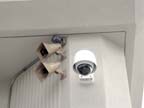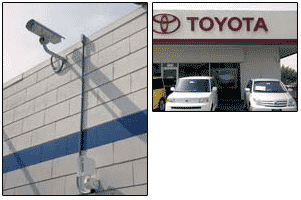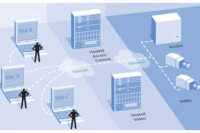
When a motion detector is tripped at an outdoor car dealership lot, a designated central station operator at SentryCom Interactive, Valencia, Calif., takes control of a pan-tilt-zoom camera and assesses the situation.
These include detecting any health or safety issues with elderly customers, helping ensure the security of long-range radio communications and tying motion detectors in with video and audio capability to meet the unique requirements of securing car dealers' lots.

Streaming video and two-way audio are tied in with outdoor motion detectors at car dealership lots monitored by central station operator SentryCom Interactive, Valencia, Calif.
Securing car dealerships
One type of business that always has been difficult to secure is the car dealership, where valuable new vehicles usually must be stored in outdoor lots. Outdoor motion detectors alone often are not suitable because occasionally potential car buyers like to stroll around after hours looking at cars.But a number of alarm companies, such as SentryCom Interactive, Valencia, Calif., have devised a security solution that appears ideally suited for the needs of car dealers. "We're tying in streaming video and two-way audio with outdoor motion detectors," remarks Kurt Strasser, SentryCom CEO.
When a motion detector is tripped, a designated central station operator takes control of a pan-tilt-zoom camera and assesses the situation. If the intruder appears to be a customer, central station operators use the audio system to say, "This is SentryCom Security. All activity on this lot is being recorded. We will monitor the lot for your safety while you are shopping."
But if the intruder is vandalizing any of the cars, the operator can inform him or her that the police have been called. Because the alarm has been verified, "It gets a very fast response," Strasser emphasizes.
Even if the vandal gets away, SentryCom personnel often have a license plate and description of the vandal's vehicle. If police are able to apprehend and prosecute the perpetrator, the dealer and its insurance company often see significant savings. SentryCom positions its offering as a guard replacement service, saving customers about 30 percent to 40 percent compared with on-site guards, Strasser estimates.
For car dealer installations, SentryCom might use from nine to 20 motion detectors. Installers cover the perimeter with curtain pattern detectors and use long-range, wide-angle detectors in interior areas where intruders are most likely to go. The company uses several different Optex models that are designed for outdoor use.
Where possible, installers mount the detectors to the side of a building, because that eliminates the need to dig up the lot to run wires. Some detectors are mounted on light poles and connected wirelessly with the alarm panel.
Police are happy with the results they have seen from SentryCom's offering, Strasser asserts, and in some cases, they even have shared information about gang members with SentryCom personnel. "When you call a gang member by name, you really get his attention," quips Strasser.

Different audio messages are broadcast over the speakers depending upon whether the people on the lot are thought to be customers or vandals.
Elder monitoring
When elderly people live alone, their adult children often like to purchase alarm or medical alert systems to help protect them. An appealing feature that can help seal the deal is to include a motion detector that signals the central station if it does not detect activity for more than a certain number of hours."We recommend it when children are buying an alarm system for their parents," notes Mike Polizzi, president of ABF Security Systems, Fenton, Mo. "They're looking for security and safety to make sure that parents can stay in their own home."
ABF Security uses a Napco passive infrared detector connected to a Napco panel for elder monitoring. Using the panel, installers have the ability to program the zone to which the detector is connected to send a supervisory signal to the central station if it is not tripped for a certain number of hours. The exact number of hours is programmable, but ABF likes to keep it at no less than six hours.
"We don't do less than six because it would cause too much central station activity," Polizzi explains. When the central station receives a supervisory signal from an account that has elder monitoring capability, central station operators first call the residence. If no one answers, they call the children or whoever is designated on a customer's call list.
Because most systems are sold with a passive infrared motion detector (PIR), ABF does not charge extra for systems with elder monitoring capability.
"We don't charge extra because it's a programming feature of the panel and adding this capability encourages customers to make the purchase," Polizzi stresses.
Although such systems consume more central station resources than conventional alarm systems, Polizzi points out that if the PIR is centrally located where the elderly person frequently passes, it will be tripped frequently. "We don't have to call too often," he reports.
Sentry Alarm Systems of America, Monterey, Calif., also offers elder monitoring but delivers the capability in a different manner than ABF. Sentry uses a Bosch motion detector that has anti-masking capability.
Although originally designed to detect when someone deliberately or accidentally blocked the PIR's view, the device works well for elder monitoring, explains John Hopper, Sentry vice president and general manager. "It looks for movement within a specified window - let's say every four hours or every 12 hours," Hopper suggests.
The detector itself tracks whether it has been tripped within the specific period of time set by the installer. If that time period is exceeded, the motion detector signals the central station. "We have the central station looking for the equivalent of an opening or closing," Hopper relates.
Because the detector is on its own 24-hour zone, it cannot function as a conventional intrusion detector as in ABF's implementation. That means it's an additional PIR for most installations, and customers are charged accordingly. However, they are not charged extra for monitoring.
Like Polizzi, Hopper emphasizes that elder monitoring does not add appreciably to the workload at the central station, although occasionally customers forget to inform the company when they are going away for a few days.

SentryCom sells its motion-detector triggered video monitoring service to car dealerships and outdoor lots as a replacement for guard service.
Long-range radio protection
Although long-range radio systems have a self-test mechanism to help ensure that no one has deliberately or accidentally tampered with them, one alarm dealer wanted to give its radio systems a higher level of security."For high-end systems, the radio is polled every six minutes, but some might be every six hours," explains George Scivolette, operations manager for Security Systems by Hammond, Poughkeepsie, N.Y.
That level of security may be acceptable when a radio antenna is installed in a difficult-to-reach location. But sometimes Scivolette's installers find they have to install an antenna above a dropped ceiling in order to help ensure satisfactory signal strength.
When that occurs, the company's procedure is to install a motion detector above the dropped ceiling. The motion detector is aimed at the antenna and put on a separate zone that is always armed. Long-range (100-foot) motion detectors with a pet alley work best for this application, Scivolette notes, adding that he uses devices from Optex and Rokonet for this purpose.
If the motion detector trips at night, the police are dispatched. If the motion detector trips during the day, it usually means that a heating and cooling technician or other worker is moving above the dropped ceiling.
A signal is sent immediately to the central station, and the company's personnel telephone the customer, who confirms that someone is working there.
"We ask them to let us know when the work is done, and then we poll the radio system from the central station to make sure it can transmit," Scivolette relates. Although an instance has not yet occurred in which the antenna had been disturbed, Scivolette likes the peace of mind that the added level of security brings.
The above-ceiling motion detector is not an optional add-on, Scivolette notes. "If we're selling long-range radio and we have to put the antenna above the dropped ceiling, we add the motion detector automatically," he insists.
